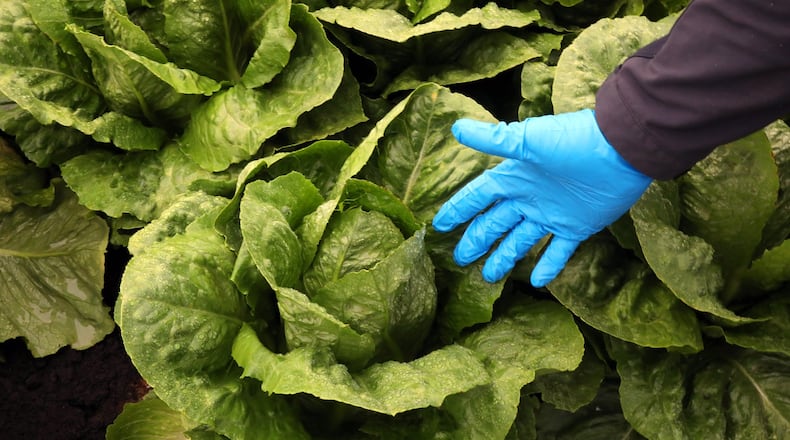Now that federal investigators have identified the central California farm believed responsible for the latest E. coli outbreak linked to romaine lettuce, consumers might believe the danger has passed.
After weeks without, romaine lettuce is making a slow and steady comeback to grocery store produce bins. Restaurants are serving it again. Yet, federal authorities aren’t ready to declare the danger has passed. They are still warning consumers against eating romaine grown in three central coastal California counties.
The great romaine recall of 2018 is a testament to how difficult it is to pinpoint tainted produce from thousands of farms across the country, despite a growing network of local, state and federal health departments tapping increasingly useful technology like genome sequencing.
Romaine has sickened at least 59 people in the U.S. since the outbreak began in early October. That triggered a rare recommendation in November from the Food and Drug Administration and Centers for Disease Control and Prevention to avoid romaine regardless of where it was grown.
Much of the effort to identify contagion in produce – including two other major E. coli outbreaks in the past 18 months tied to lettuce - runs through the CDC’s headquarters here in Atlanta.
Investigations increasingly rely on the use of DNA science to identify the sources of E. coli bacteria that can cause potentially deadly infections. But a good bit of the network’s labor is spent sleuthing in more low-tech ways: Infected people are interviewed to identify clusters of illness; soil and water samples are collected at suspected farms; equipment at processing plants is swabbed for the slightest of biological clues that will lead them to the origin of an outbreak.
Credit: Smith Collection/Gado
Credit: Smith Collection/Gado
A dangerous strain
In the days running up to the Oct. 5 outbreak, someone in California ate a meal that contained romaine lettuce. That person was one among millions, since industry estimates show Americans consume roughly 30 million servings of romaine daily. And according to a joint study by Colorado State University and the Colorado Department of Public Health, about 30 percent of lettuce consumed in the U.S. each year is romaine. What made this one individual different: That person began to feel sick within days of eating the lettuce.
By Oct. 12, six more people in Michigan and Maryland became ill after eating romaine. Given the hallmarks of an E. coli infection, their symptoms would have been similar: abdominal pain and cramps, diarrhea and, in some cases, bloody stool. Those symptoms would have become unbearable and would have made them seek a doctor’s care. Those patients were the first clue that something was bad in the food supply.
“It begins with multiple people getting bacteria with the same (DNA) fingerprint that’s making them sick,” said Dr. Matthew Wise, deputy branch chief for outbreak response with the CDC. “Where we pick up is, ‘What do they have in common?’”
Those hints are found in stool samples taken from the sick people. With food-borne illnesses, laboratory reporting requirements vary from state to state, but it can take several days and sometimes weeks for a lab to process a sample and get results. That delay can be crucial when contaminated food is out on grocery shelves.
While E. coli naturally occurs in the gut of a healthy person, the strain known as E. coli 0157 is particularly dangerous and can be a killer. By the second week of November, just days before people were going to sit down to Thanksgiving meals, that strain began popping up in laboratory samples in 11 states from California to New Hampshire.
The next clue was discovered in large part thanks to a vast network of local, state and federal health agencies, called PulseNet. The network, which operates in the CDC’s Clifton Road campus, collects data to prevent or contain food-based outbreaks and identify the original source of illness.
Within the last nine years, PulseNet has begun using a type of testing called “whole genome sequencing.” Bacteria contain DNA that’s unique and can be used as an identifier. The sequencing generates a detailed genetic blueprint that researchers can use to trace the bacteria to its source.
That genetic blueprint was key in November. Researchers saw a strong genetic link between the bacteria in this outbreak and that of a similar outbreak a year ago in the U.S. and Canada traced to leafy greens from California. Though people got sick, no one died. In that case, U.S. researchers never determined which type of leafy green was responsible, so no public warning to avoid all leafy greens was issued.
This fall, in what increasingly looked like a multi-state outbreak, investigators needed to be sure that the source was leafy greens and, more importantly, which green.
Finding ground zero
Police investigators interviewing witnesses is a familiar scene to those who watch crime dramas. Epidemiologists at health departments do very similar work when they are looking for a common food that links a cluster of ill people.
“You may identify a common event like, ‘We had an office party or church pot luck,’” said Dr. Melissa Tobin-D’Angelo, an epidemiologist with the Georgia Department of Health. “And in the course of an investigation you may do several interviews.”
Those interviews, combined with lab samples, are what led the CDC and FDA to definitively identify romaine as the culprit in this case. But two days before Thanksgiving, investigators still weren’t sure exactly where the lettuce came from, so they issued the blanket warning against eating any romaine. They didn’t publicize yet another clue they were still working to confirm: the genome sequencing had led them to the Central Coast in California.
The day after Thanksgiving, and six weeks after the first people were reported sick, teams of FDA, CDC and California Health Department researchers were in the fields, processing plants and distribution centers across six coastal California counties. They were combing for contamination that matched the DNA of the culprit.
By early December they were reasonably certain they’d found ground zero: Adam Brothers Family Farm in Santa Barbara County, California. Sediment in a water reservoir used for irrigation on the property came up positive for the dangerous E. coli 0157. On Dec 13, Adam Brothers announced a voluntary recall of several other varieties of their lettuce — red and green leaf lettuce and cauliflower products — “out of an abundance of caution.”
Credit: Justin Sullivan
Credit: Justin Sullivan
‘Do more work’
Health officials acknowledge the sweeping recall that removed all romaine from stores and restaurants was a drastic step, but it seemed to work at containing what was starting to look like a runaway outbreak.
“We believe the market withdrawals were very effective from preventing additional cases,” Dr. Stephen Ostroff, a senior FDA adviser, said. “It’s premature to say it’s over, but it’s probably safe to say the (contaminated) product is off the market.”
Even now, the entire outbreak hasn’t been completely tied to the California farm’s romaine, Ostroff said.
Investigators were still visiting processing plants and cooling facilities in recent weeks to determine whether machinery that touched the contaminated romaine lettuce also touched other types of greens or whether the E. coli strain came from yet a different source.
“It’s pretty rare that these people ate romaine just one time before they got ill,” said Ostroff. “They may have had many meals with romaine. We’re going to have to do more work.”
How long that will take is unclear. For now, that’s about the only guidance that’s certain for consumers looking to eat a salad after over-indulging on treats during the holiday season.
CDC advises that U.S. consumers not eat and retailers and restaurants not serve or sell any romaine lettuce harvested from certain counties in the Central Coastal growing regions of northern and central California.
Some romaine lettuce products are now labeled with a harvest location by region. Consumers, restaurants, and retailers should check bags or boxes of romaine lettuce for a label indicating where the lettuce was harvested.
Do not buy, serve, sell, or eat romaine lettuce from the following California counties: Monterey, San Benito, and Santa Barbara.
If the romaine lettuce is not labeled with a harvest-growing region and county, do not buy, serve, sell, or eat it.
About the Author
The Latest
Featured





